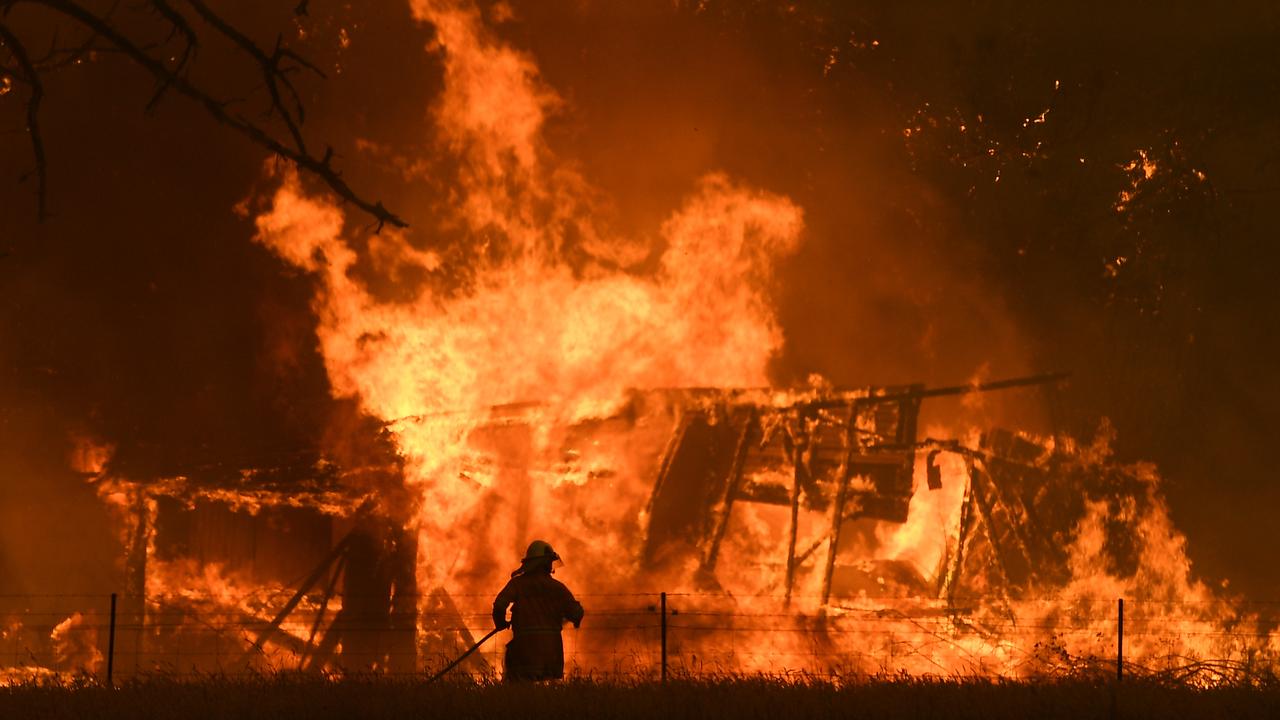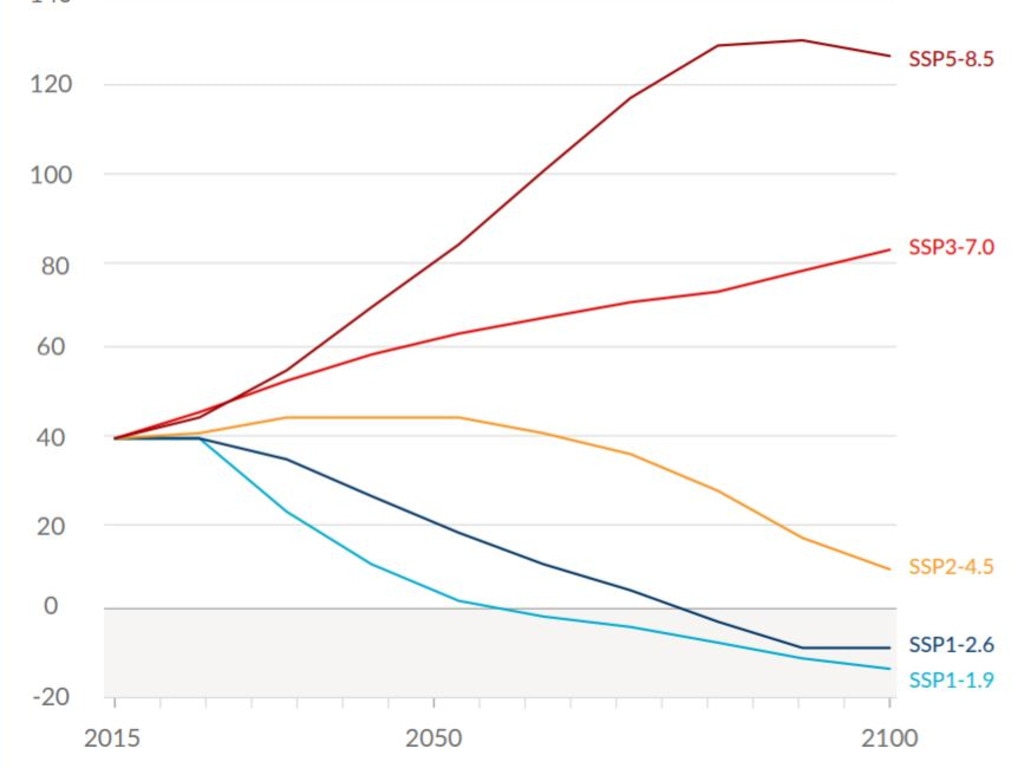Why Australia only has 10 years to act on climate change
The world only has 10 years to act on climate change and these are the consequences to Australia if we don’t change our path.
Australia is already experiencing irreversible impacts of climate change and the world is running out of time to change course.
In just 10 years, the opportunity to avoid some of the worst impacts will likely be lost, making it essential that action is taken now to bring down emissions.
Prime Minister Scott Morrison is under increasing pressure both in Australia and from his overseas counterparts to commit to net zero by 2050, and to set a more ambitious 2030 target.
News.com.au is looking at the impacts of climate change across Australia as part of its Time Is Now series, in partnership with the Monash Climate Change Communication Research Hub.
This is why it’s so important.
It’s already happening
Australia has already warmed by 1.4C – much higher than the global average of 1.1C, according to the latest report from the United Nations’ Intergovernment Panel on Climate Change (IPCC).
The significant rise in temperatures is already having impacts, with the IPCC report noting that Australasia, which includes New Zealand, has already experienced more hot extremes, higher rates of sea level rise than the global average, decrease in snow cover and depth, an increase in the frequency of fire weather days, a longer fire season and less rainfall during winter in southern Australia.
It also locks in certain irreversible changes to sea level rise, ocean warming and the melting of glaciers.
Where we are headed: 3C by 2100
Based on current climate pledges, global temperatures will exceed 1.5C of warming within 20 years.
Up to 2.5C of warming within 40 years is expected, with the world on track for 3.5C of warming by 2100.
This is roughly in line with a medium emissions scenario called RCP4.5, which is based on the volume of greenhouse gases emitted.
Under this scenario, the world would warm 2C by around 2050, making “1-in-10 year” heat events likely to occur five times instead, and to double the number of droughts. One-in-50 year events would occur 13 times. The world’s coral reefs would virtually be wiped out.

Australians would also see big changes in their local areas, as analysis provided to news.com.au exclusively by the Monash Climate Change Communication Research Hub reveals.
Average summer temperatures would be expected to rise by an average of between 0.9C and 2.2C across all local government areas analysed in Australia.
Sea levels would also be expected to rise by up to 0.76 metres by 2100, compared to 1995-2014.
How bringing down emissions will make a difference
Keeping global warming to around 1.5C is what many experts believe the world can, and should, aim for.
This would require the world to get its carbon emissions down to “net zero” by 2050 at a minimum, although some believe this may not be enough and emissions may need to come down by as early as 2035.
Temperatures would be expected to reach 1.5C in the 2030s, then rise to 1.6C before dropping down to 1.4C at the end of the century.
This low emissions scenario is possibly the best that can be achieved at this late stage as it would require big changes to emissions intensive sectors like electricity networks.
However, it could make a significant difference to our environment.

Sea level rise would be restricted to around half a metre and the loss of coral reefs limited to between 70 to 90 per cent.
The more warming increases beyond 1.5C, the more unpredictable climate change impacts become, the IPCC report has warned. Extreme scenarios such as ice sheet collapse or abrupt ocean circulation changes could not be ruled out at higher temperatures, despite them being very unlikely.
Climate-related risks to health, livelihoods, food security, water supply, human security, and economic growth would also increase at higher temperatures.
We’ve got 10 years
To keep temperatures at 1.5C, Australian National University Professor Mark Howden says the world has got about 10 years at the current rate of emissions before the carbon budget is exhausted and rises of above 1.5C are locked in.
“What we do in the next 10 years is critical,” Prof Howden told news.com.au.
“One of the significant findings of the IPCC report is that the carbon budget consistent with keeping temperatures under 1.5C is being used up frighteningly quickly.”
Prof Howden said any hope of keeping temperatures below 1.5C was now gone but there was no physical or biological reason the world could not avoid warming of more than 1.5C.

He said it was important not just to have a long-term goal, such as net zero by 2050, but also to have short term goals that keep us on track to achieve this. This is one reason why there is pressure on countries to commit to a more ambitious 2030 target as well.
What it’s going to cost us if we don’t act
Reserve Bank analysis has revealed climate change could lead to a fall in house prices and increased insurance costs.
As news.com.au recently reported, many homeowners are unaware of these risks as the impact on properties have often not been made clear but these could impact people by the time they pay off their mortgages.
There is also the risk of higher interest rates as international banks are likely to increase the cost of borrowing for governments that don’t act quickly enough on climate change.
Interestingly, Queensland Nationals senator Matt Canavan told Sky News’ Keiran Gilbert that Australians should be prepared to pay higher interest rates.
“Some things are worth paying for,” Mr Canavan said.
A Climate Council report released this week says there would be serious economic consequences – including 20,000 jobs at risk in NSW – from carbon border tariffs unless Australia cuts its emissions in line with its major trading partners.
Last month, Treasurer Josh Frydenberg argued that not moving quickly enough could see Australia left behind by international markets.
The Business Council of Australia has also changed its tune, announcing its support of a net zero target and a more ambitious 2030 emissions reduction target of between 46 to 50 per cent below 2005 levels.
The BCA noted that Australia’s biggest trading partners were already making the transition as were global capital markets and local businesses. It said acting now could leave average Australians $5000 better off per year, and those in the regions would gain the biggest economic benefit.
Where Australia stands
Every state and territory in Australia has set a net zero by 2050 target and New South Wales recently revealed a bold new 2030 goal to slash emissions by 50 per cent below 2005 levels.
But nationally, Prime Minister Scott Morrison has only said Australia would get to net zero “preferably” by 2050. Its 2030 target to reduce emissions by 26 to 28 per cent has also been criticised for being too low.
Mr Morrison is under pressure to announce a more ambitious goal ahead of the Glasgow Climate Change Conference beginning on October 31 but it’s still unclear whether he will attend the conference.
Close to 60 countries now have a net zero goal including the United States, France, New Zealand, Canada, South Korea, Japan, Brazil and Spain. Around half of them have set their targets down in law. Even China has set a net zero deadline for 2060.
The US has also announced an interim 2030 target for a 50 per cent reduction and it’s likely other nations will announce the same at Glasgow.
There is increasing support from Australians for climate action, with a nationwide YouGov poll commissioned by News Corp Australia showing 58 per cent thought the country should switch to 100 per cent renewable energy such as solar, wind and hydro by 2050.
A report from the Australia Institute released this week found concern about climate change was at an all-time high with 75 per cent of those surveyed saying they were worried, and 62 per cent supporting the phase-out of coal-fired power stations.
What we need to do
Phasing out coal-fired power is crucial to reducing emissions, especially in the electricity sector.
Some experts believe the electricity sector would need to get to net zero emissions by 2040 if the world wants to keep warming to 1.5C.
This would require a massive change to electricity networks around the world within 20 years.
A report from the International Energy Agency suggested the least-efficient coal-fired power plants should be phased out by 2030 and all coal by 2040.
It also said there could be no new investment in fossil fuel supply projects, no further final investment decisions for new coal plants, and no new sales of internal combustion engine passenger cars by 2035.
Gas will also have to phased out in order to reach net zero emissions, which is why some experts believe Australia should not be building more gas-fired power plants and the focus should instead be on technology like batteries to make renewables more reliable and to improve energy efficiency.
Removing emissions from the electricity sector would also help countries reduce emissions in other sectors, such as transport.
Emissions from transport, which accounts for 17.6 per cent of Australia’s emissions, have increased by 43 per cent since 1990 despite the recent disruption caused by the coronavirus pandemic.
More Coverage
United Nations secretary-general Antonio Guterres has said the internationally agreed threshold of 1.5C is “perilously close”.
“We are at imminent risk of hitting 1.5 degrees in the near term,” he said.
“We must act decisively now to keep 1.5 alive.”






